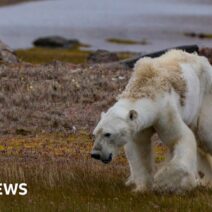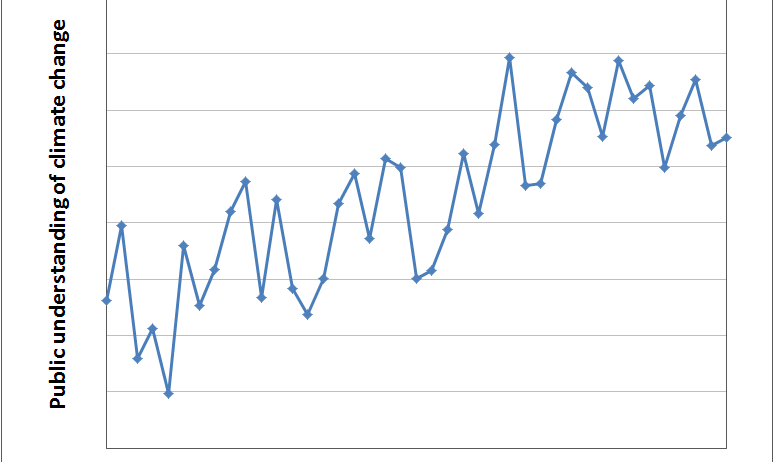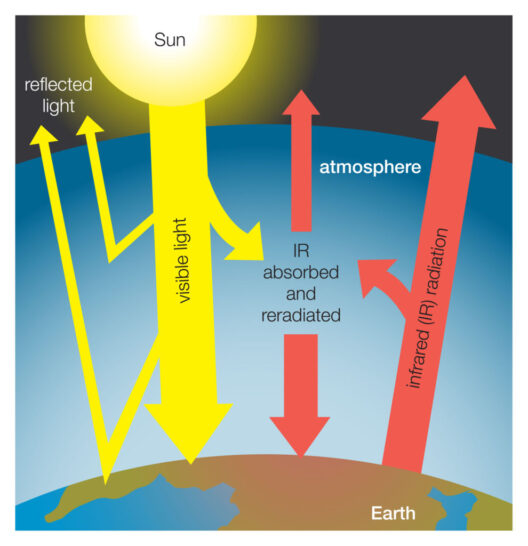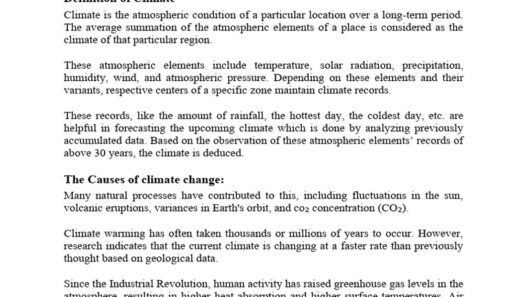Climate change is a term frequently employed in public discourse, yet its nuances often elude comprehensive understanding. To dissect the intricacies of this phenomenon, it is essential to first establish a foundational definition. Climate change refers to significant alterations in temperature, precipitation, wind patterns, and other indicators of climate that persist for an extended duration, typically decades or longer. While climate fluctuations occurring over eons can be attributed to natural events, the contemporary dialogue predominantly revolves around anthropogenic climate change—global changes induced by human activities.
Understanding climate change demands an exploration of its potential ramifications, driving forces, and societal responses. From melting polar ice caps to severe droughts and intense weather events, the manifestations of climate change are unequivocally evident. As we delve deeper, we confront the complexity of the systems involved and the multifaceted dimensions of climate intervention.
Defining the Drivers of Climate Change
At the core of climate change are greenhouse gases (GHGs), which are paramount to understanding the warming of our planet. Carbon dioxide, methane, nitrous oxide, and fluorinated gases are the primary culprits. Emissions from industrial activities, vehicular transport, and deforestation contribute significantly to atmospheric GHG concentrations. Each of these gases possesses a varying potential for heat retention, which directly impacts global temperatures.
Carbon dioxide, for example, is primarily released through the combustion of fossil fuels and land-use changes. Its longevity in the atmosphere—up to a century or more—ensures a persistent warming effect, making it a critical focus in climate change mitigation strategies. Methane, although less abundant, is over twenty times more effective than carbon dioxide at trapping heat over a similar timeframe. Sources include agricultural practices such as livestock digestion and rice cultivation.
The interplay between these gases illustrates an intricate web of causality. Human operations, particularly during the industrial revolution, led to an exponential increase in GHG emissions, creating a significant imbalance in the Earth’s natural systems. Understanding the mechanisms through which human activity influences climate can unify efforts toward meaningful action.
Impact: Consequences on Weather Patterns and Ecosystems
The ramifications of climate change extend far beyond theoretical projections; they manifest in tangible and disruptive ways across the globe. Weather patterns are becoming less predictable, with increased frequency and intensity of extreme weather events such as hurricanes, floods, heatwaves, and wildfires. These events inflict considerable damage on human infrastructure, ecosystems, and livelihoods.
Moreover, ecosystems experience dramatic transformations as species attempt to adapt to rapidly changing climates. Habitats such as coral reefs, forests, and polar regions face unprecedented stress, leading to biodiversity loss and potential extinction of various species. Ocean acidification, driven by increased carbon dioxide absorption, poses a dire threat to marine life, undermining fisheries and coastal communities that depend on these resources. This disruption transcends ecological boundaries and risks food security and economic stability.
The socio-economic consequences of climate change are multifaceted. Disparities between nations intensify as developing regions grapple with the challenges of climate adaptation, often with limited resources to mount an effective response. Climate refugees, individuals displaced by environmental catastrophes, amplify the urgency of addressing climate vulnerabilities—demonstrating that climate change is not solely an environmental issue but a profound humanitarian crisis.
Mitigation and Adaptation: Addressing the Challenges
Confronting the pressing challenges posed by climate change necessitates a dual approach: mitigation and adaptation. Mitigation strategies focus on reducing GHG emissions and enhancing carbon sinks, while adaptation strategies aim to bolster resilience against the impacts of climate change.
Mitigation techniques can be varied and ambitious. Transitioning to renewable energy sources—such as solar, wind, and geothermal—reduces dependence on fossil fuels and curtails emissions. Afforestation and reforestation initiatives play a pivotal role in sequestering carbon dioxide, while sustainable agriculture practices can enhance productivity while reducing emissions. Innovations in technology, including carbon capture and storage (CCS), present exciting opportunities for curtailing future emissions.
Successful adaptation strategies are equally critical. Constructing resilient infrastructure, investing in water conservation technologies, and enhancing agricultural practices to withstand climatic shifts ensure that communities can cope with changing conditions. Recognizing the vulnerability of marginalized populations is crucial, as they often bear the brunt of climate impacts without the means for effective adaptation.
A Collective Responsibility: Global Action and Local Initiatives
Addressing climate change is an endeavor that transcends individual borders; it requires robust global cooperation and local commitment. International agreements like the Paris Agreement foster collaboration among nations to pursue ambitious emission reduction targets. Such frameworks set an imperative for nations to undertake actionable steps toward a sustainable future.
Yet, local initiatives also serve as vital components in the broader climate action tapestry. Communities worldwide are engaging in restoration projects, sustainable urban development, and grassroots activism to safeguard their environments. The intersection of local knowledge and global initiatives highlights the importance of collective responsibility in combating climate change.
Ultimately, clarity surrounding climate change bridges the gap between awareness and action. By demystifying this critical issue, individuals, communities, and nations can forge pathways toward resilience and sustainability. In our shared endeavor to mitigate and adapt to climate change, informed understanding serves as a powerful tool to mobilize action and usher in a more equitable and sustainable world.







